I’ll be straight with you: I’m not a full-time developer. I’m a tech writer who regularly gets tossed into new tools and trends, then comes back with honest notes so you don’t have to figure it all out alone. I don’t just skim the surface either. If something’s bad, it reflects on me and I take that seriously. So I test these platforms like my reputation depends on it because it actually does.
Until recently, someone like me who doesn’t live and breathe code would’ve never imagined spinning up a project from scratch with help from AI. But here we are. It’s 2025 and thanks to tools like Cursor, Replit and Bolt, coding feels way more accessible. If you’re curious, motivated and maybe a little impatient, these tools might be your new best friends.
That’s why I decided to test them side by side, not as a dev looking for enterprise power but as someone who wants to build quickly without wrestling with setup or clunky interfaces. I was looking for something smooth, focused, and fun to use. All three tools had their strengths, but only one made me say, “Okay… this is actually addictive.” Let’s dive in.
TLDR: Key takeaways from this article
- Vibe coding means outcome-first, AI-assisted flow. You describe what you want; the AI handles the code.
- Cursor wins for deep focus and local dev flow. Minimal distractions, strong GitHub integration, and context-aware AI make it ideal for solo devs who like clean environments.
- Replit shines for fast builds and social energy. Browser-based, beginner-friendly, and great for collaboration, but its hyperactivity can disrupt deep work.
- Bolt is built for creative sprints and rapid MVPs. Its full-stack scaffolding and integrations (Stripe, Supabase, etc.) make it perfect for turning ideas into live apps fast.
- All three tools are powerful. The real question is: which one matches your workflow, energy, and coding rhythm right now?
What is vibe coding, and why does it matter?
Vibe coding is an emerging approach to software development where large language models (LLMs) generate code based on natural language prompts. Instead of writing everything line by line, you describe what you want to build, the vibe of the feature, app, or interaction, and the AI handles the implementation.
It’s high-level, intent-driven coding: You focus on what you want, and the LLM figures out how to make it happen.
Why does it matter?
Because it shifts the developer’s role from code typist to creative director, it unlocks faster prototyping, more flow-state work, and less time Googling syntax or debugging boilerplate. In a world where attention is fractured and projects move fast, vibe coding gives you momentum without sacrificing output.
It’s not perfect. But when it works, it feels like cheating in the best way possible.
What are Cursor, Replit, and Bolt?
Before I dive into how these tools feel in use, here’s a quick primer on what they are and what makes each one unique. These aren’t just editors with an “AI” sticker slapped on. They’re built for developers who want something more intuitive, conversational, and flow-focused.
What is Cursor?
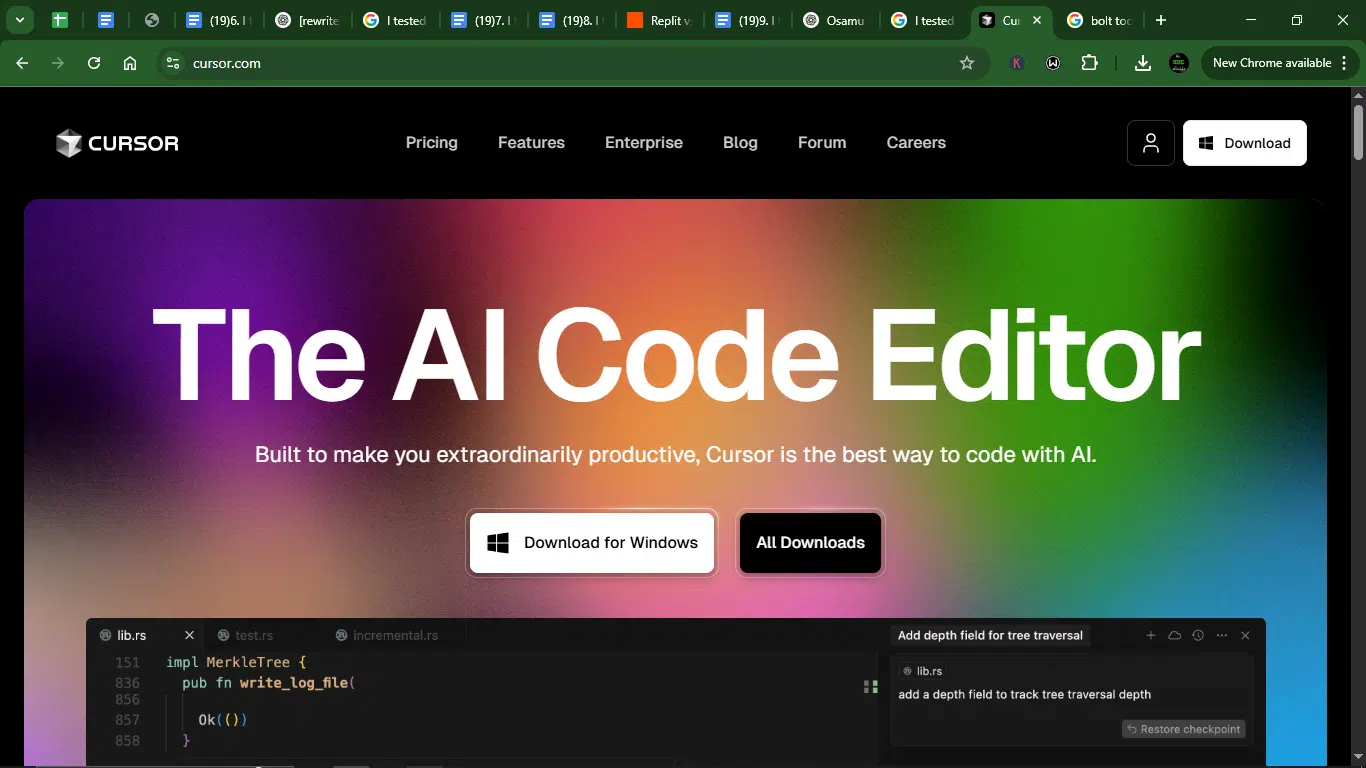
Cursor is a coding-first IDE built. The tool is designed for devs who want more than a typical chatbot; it’s an AI deeply integrated into workflows. That is, a tool that feels like a hands-on coding buddy that goes through your project context, suggests improvements, edits files, and debugs with you.
Unlike Claude or ChatGPT, Cursor doesn’t excel at small talk and putting together cooking recipes. It doesn’t pretend to be your coding BFF. It just gets to work, and during my testing, that vibe felt pretty refreshing.
Cursor at a glance:
| Developer | Anysphere Inc |
|---|---|
| Year launched | 2023 |
| Type of AI tool | AI-powered coding IDE |
| Top 3 use cases | Pair programming, code generation, and debugging |
| Who is it for? | Developers, indie hackers, and startup teams |
| Starting price | $20/month |
| Free version | Yes (with limited AI requests) |
What is Replit?
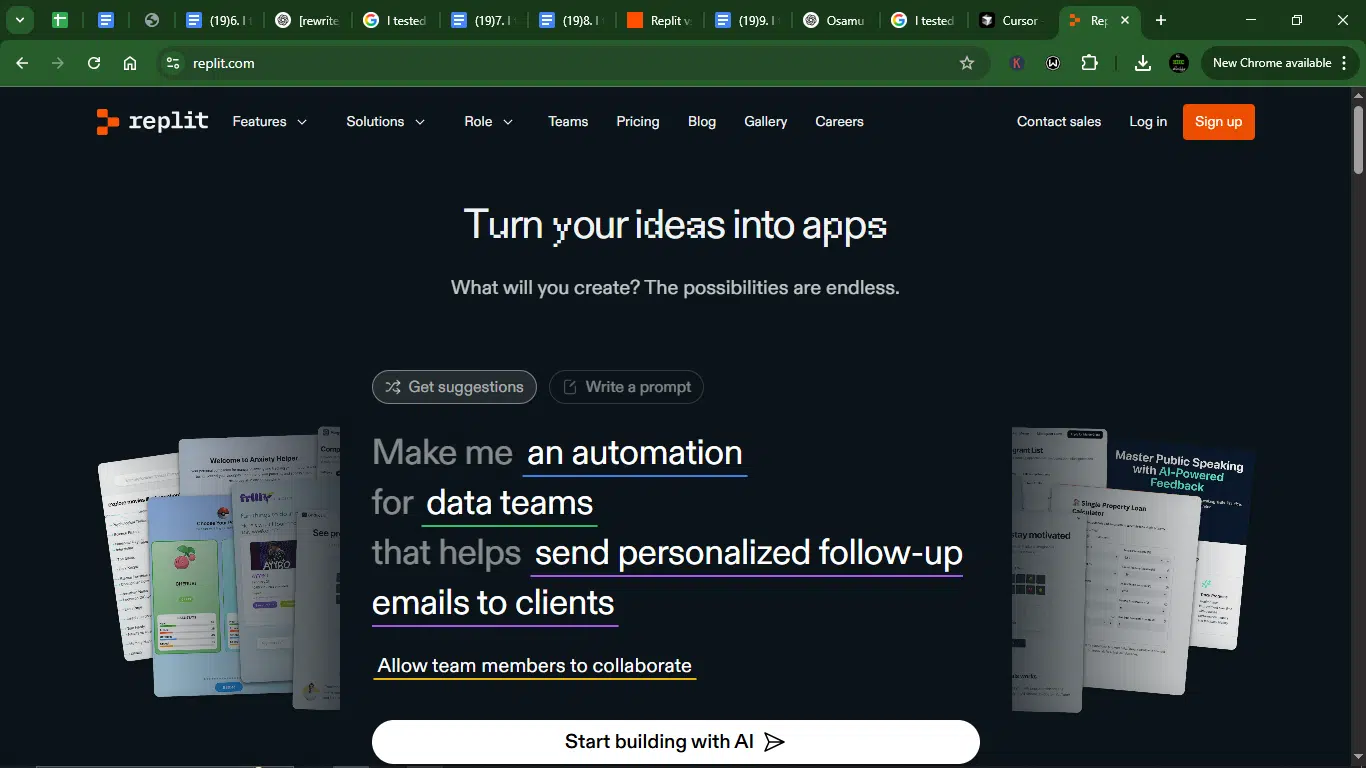
Replit is an in-browser collaborative IDE that’s been around for a while, but it’s evolved into much more than a place to “just code.” With the addition of Replit AI and its native model, Ghostwriter, it’s become a full-blown cloud dev environment, one that lets you spin up projects, build, deploy, and get AI coding help all in one place.
Replit’s strength is in collaboration and accessibility. Think of it as the Google Docs of coding. You can invite teammates, test ideas in any language, and use AI to suggest, fix, or even explain code.
Replit at a glance:
| Developer | Replit |
| Year launched | 2016 (Ghostwriter AI in 2023) |
| Type of AI tool | Browser-based IDE with AI coding assistant (Ghostwriter) |
| Top 3 use cases | Collaborative coding, rapid prototyping, and AI code help |
| Who is it for? | Students, indie devs, educators, hacker teams |
| Starting price | $10/month |
| Free version | Yes (limited features and basic coding environment) |
What is Bolt?
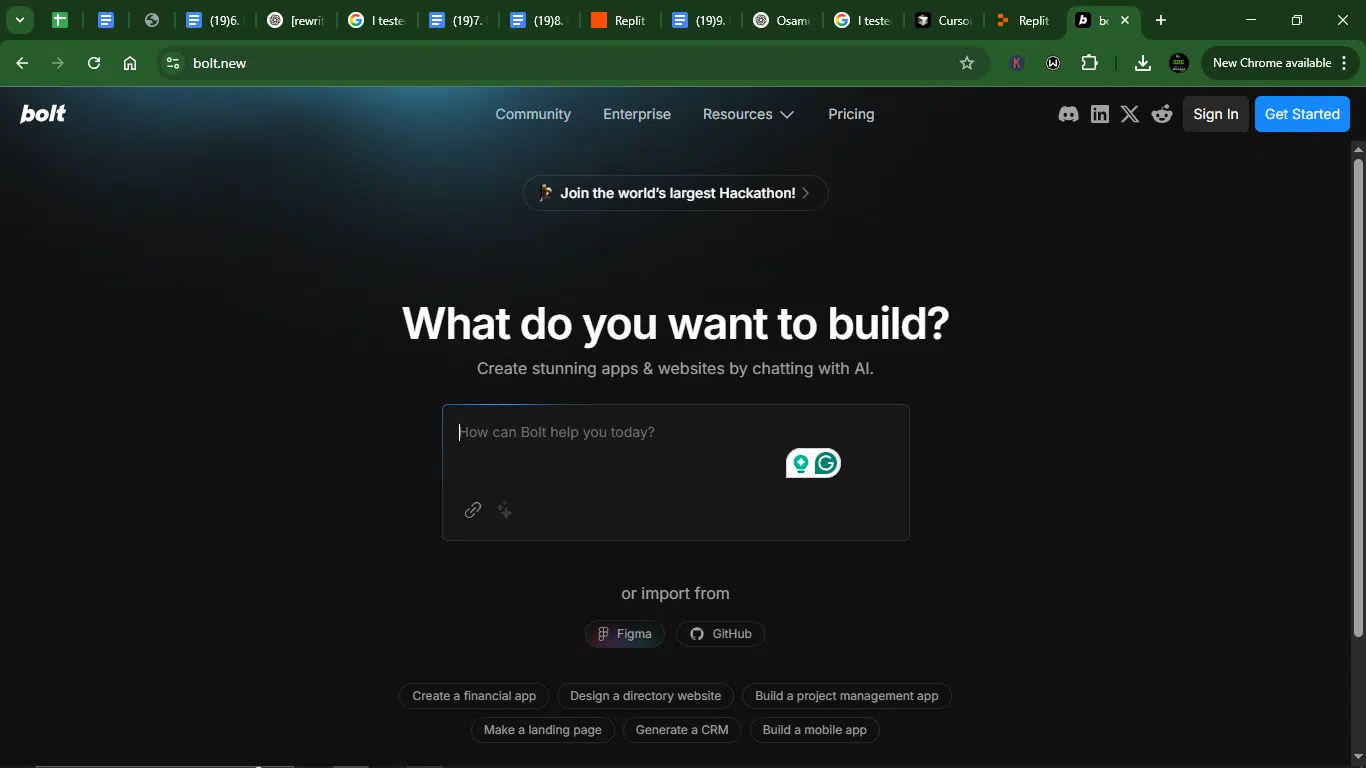
Bolt is a full-stack, AI-native coding environment. Describe what you want built, and it scaffolds out the frontend, backend, preview, and deploys it, complete with Stripe integration and live hosting. It’s built for fast idea-to-app flow, and even non-coders can whip up working prototypes with ease.
Bolt at a glance:
| Developer | Stackblitz (bolt.new) |
| Year launched | 2024 |
| Type of AI tool | AI-native full-stack app IDE |
| Top 3 use cases | App prototyping, full-stack scaffolding, deployment |
| Who is it for? | Technical founders, indie hackers, product-side devs |
| Starting price | $20/month |
| Free version | Yes (with limited tokens/trial) |
Setup and first impressions
Let’s talk setup. If you’ve ever rage-quit a tool before writing your first letter, you know how underrated setup UX is. At first glance, it just works or doesn’t.
Here’s how each tool showed up straight out of the box (or browser).
Cursor
First, you have to download Cursor for your specific device. It installs like a traditional desktop app. No drama. It boots up fast, skips the fluff, and throws you right into a blank workspace that lets you start coding. Within five minutes, I’d gone from loading the app and triggering my first AI suggestion.
The setup’s dead simple:
- Install > Log in > Pick project > Start.
- Themes are dark, clean, and vibe-friendly.
- Cursor’s UX leans VS Code-ish but stripped down to what matters.
No loading bar animations. No welcome confetti. Cursor means business.
Replit
Replit is the “walk-in and start jamming” tool. No install needed. All you have to do is sign in, and you’re dropped into a fully functioning code workspace, complete with terminals, file trees, version control, and its AI Ghostwriter already hovering, waiting to help.
For my first impressions, the setup was instant: I opened the URL, picked a template, and was coding in under a minute. The UI has more going on than Cursor, and it’s organized well. The collaboration setup was buttery smooth; you can invite a friend in with one click.
If you like instant access and don’t want to worry about system compatibility or local dependencies, Replit delivers.
Bolt
Same as Replit, no installs needed. Bolt came out of left field. It’s still a bit niche compared to Cursor and Replit, but the setup is as straightforward as Replit. Smooth, polished, and minimalist. For a moment, there’s a quiet animation on launch that seems more like opening a design tool than a code editor.
First setup felt like a breeze. Bolt’s vibe is bright, modern, and expressive. You get lots of customization: fonts, layout density, and even animated transitions between tabs. It nudges you toward creative flow with little things like smart tab snapping and a Zen Mode toggle. It didn’t just want me to code. It wanted me to enjoy coding.
Setup summary
| Tool | Setup speed | First impressions | Best for |
| Cursor | Fast | Clean, focused, frictionless | Professional devs, complex projects, VS Code lovers |
| Replit | Very fast | Instant coding, multiplayer magic | Beginners, quick prototyping, Teams, students, browser-first |
| Bolt | Very fast | Playful, polished, customizable | Creative coders, UI/UX thinkers |
AI coding experience: Who helped me code smarter?
Flashy UI aside, if the AI isn’t context-aware, fast, and useful, I’m out. I tested all three tools across real coding tasks, from building a React component to debugging a weird loop, and here’s how each one showed up.
How I tested Cursor, Replit, and Bolt
I didn’t run benchmarks. I didn’t simulate team workflows or enterprise use cases. I approached this like a solo dev trying to build things quickly, creatively, and with minimal friction.
What I compared
I set up the same small project idea across all three tools: a simple full-stack app with authentication, a dashboard view, and one AI-generated feature. Then I used each platform’s native AI to scaffold, write, refactor, and debug as needed, all without relying on external IDEs or Googling for help.
The goal was to see how well each tool supported a typical indie developer workflow:
- Can I describe what I want and get something useful back?
- Does the AI understand context and help improve my code?
- Can I stay in flow, or do I keep hitting friction points?
What I paid attention to
Here’s what I focused on:
- Flow and friction. How easy is it to go from idea to implementation without breaking focus?
- AI Intelligence. Does the assistant understand context, suggest relevant code, and explain it well?
- Speed and responsiveness. How fast is the editor, preview, and AI feedback?
- UI/UX and developer comfort. Is the interface clean, keyboard-friendly, and pleasant to work in for hours?
- Debugging and iteration. How does it handle errors, rewrites, or changes in scope?
- “Would I come back?” Factor: Did the tool leave me wanting to use it again?
This wasn’t about picking a winner based on specs. It was about which one felt like it got me, and made me want to keep building.
An example
I used this real-world prompt to test the three AI tools. I tested how well each tool handles backend logic, database setup, and secure login flow. This checks for context awareness and LLM understanding of auth patterns.
Prompt: “Build a basic user authentication system using Node.js and Express. It should allow users to sign up, log in, and log out. Use bcrypt to hash passwords and JWT for session handling. Store user data in a SQLite or MongoDB database. Also include basic error handling and status responses.”
Cursor response:
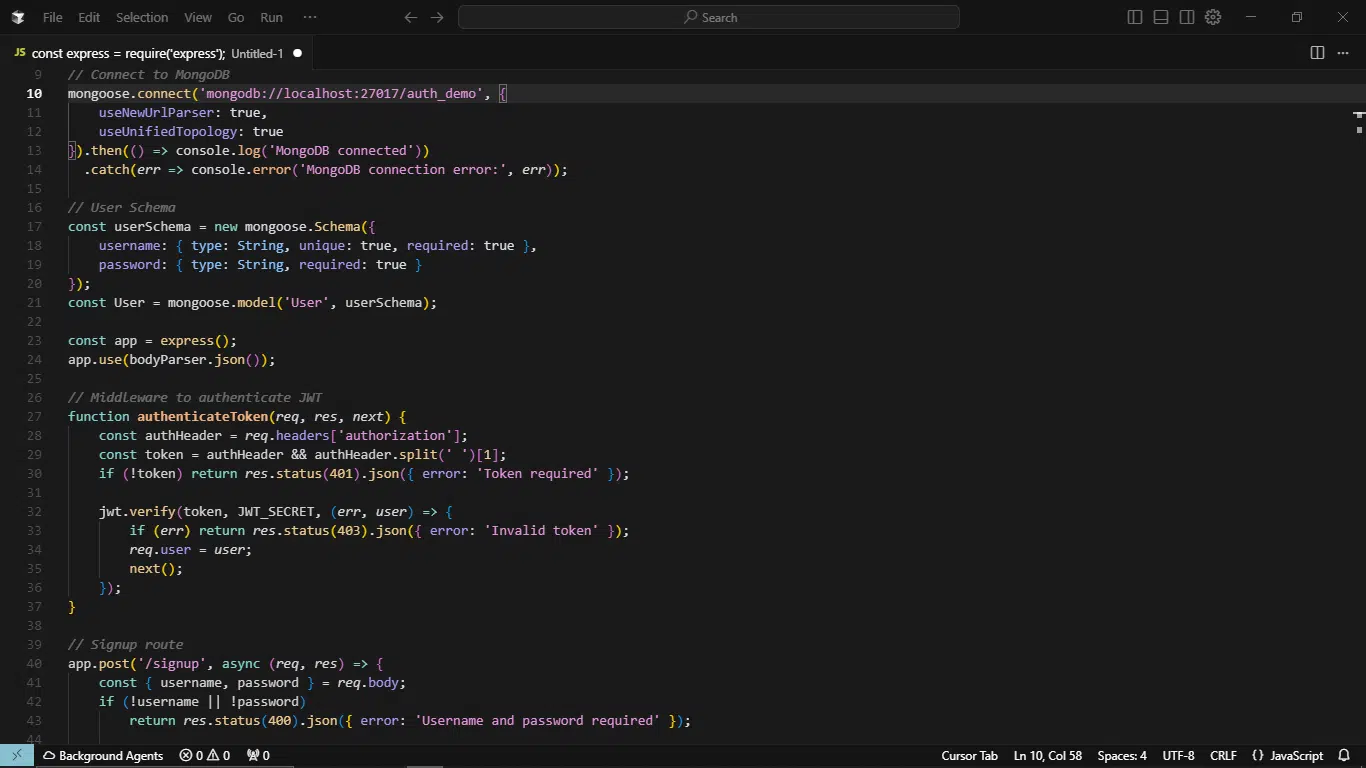
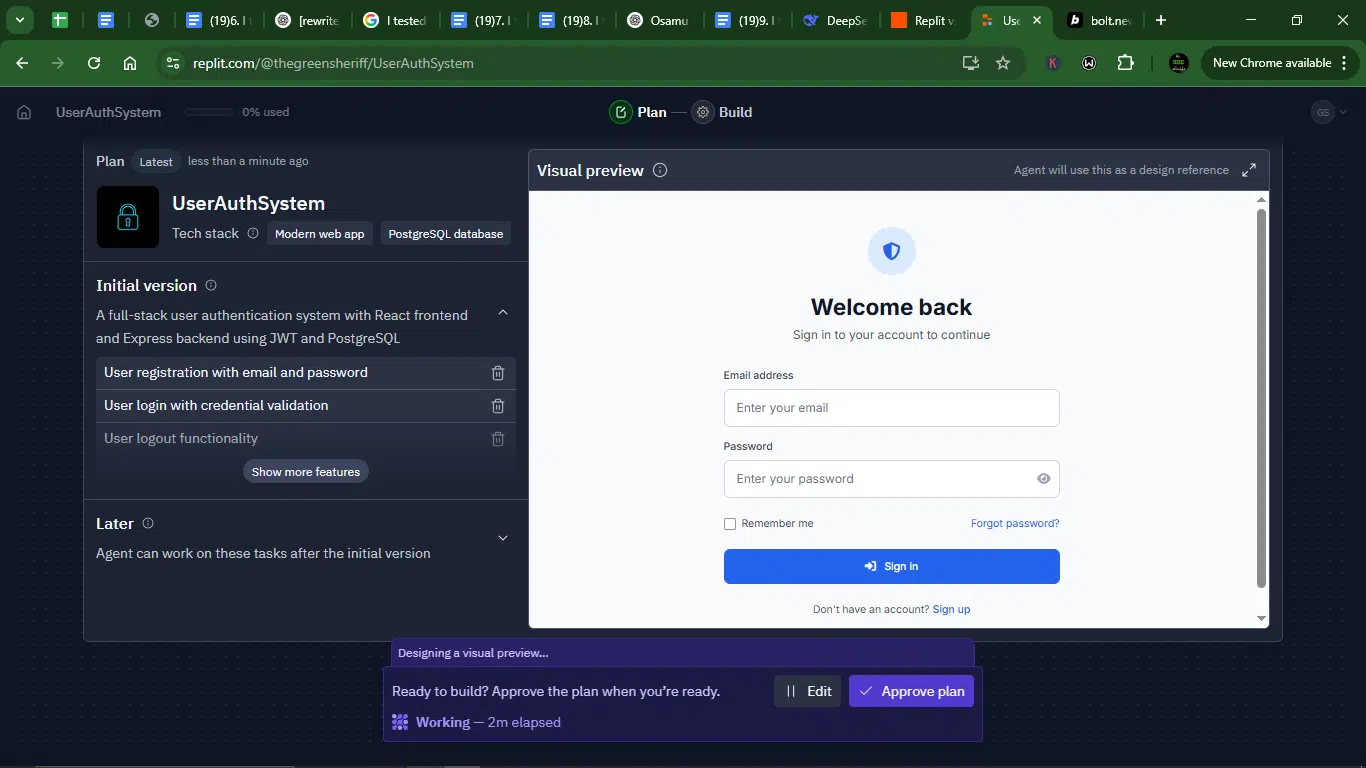
Bolt response:
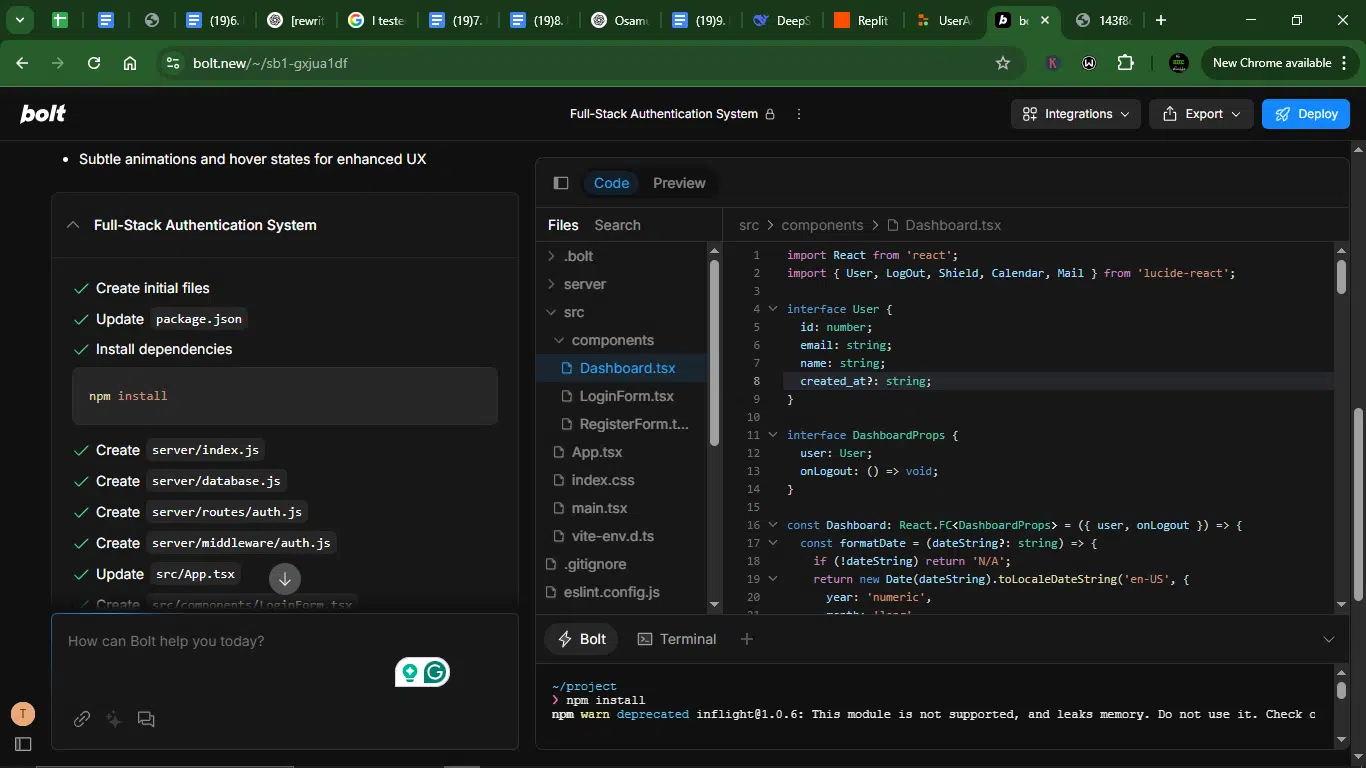
Accuracy
- Cursor directly delivered a complete, functional Node.js/Express backend with MongoDB, JWT, bcrypt, and error handling. Followed the prompt exactly.
- Replit failed to use SQLite/MongoDB (blocked dependencies) but offered alternatives (PostgreSQL + React). Provided a full-stack solution but deviated from the pure backend API request.
- Bolt provided a React frontend dashboard UI and a clean backend.
Creativity
- Cursor gave a standard implementation but included a protected /profile route as a bonus.
- Replit offered a creative workaround with a React frontend and PostgreSQL, but not what was asked.
- The Bolt app had a polished UI with gradient designs and security badges but was impressive on the backend task.
Clarity
- Cursor had well-structured code with comments, clear route definitions, and error messages.
- Replit explained limitations upfront and documented the alternative approach.
- Bolt also had well-done code with clean backend logic to evaluate; UI code was clean.
Usability
- Cursor gave a production-ready code. Just add environment variables and deploy.
- Replit’s response is usable if you want a full-stack app, but extra work to strip down to just the API.
- Bolt is ready to use, too.
Context handling and memory
- Cursor maintained context by including all requested features (signup/login/logout/JWT).
- Replit remembered the need for auth but switched stacks without asking for confirmation first.
- Bolt also maintained context by including all requested features.
In summary, Replit’s dependency limitations significantly altered the task, while Bolt and Cursor delivered exactly what was needed.
Here’s my overall experience
After testing all three, here’s what I found:
Cursor
Cursor’s AI gives the vibe of a thoughtful pair programmer. It doesn’t flood the screen with guesses; it waits, reads the room (aka your files), and offers code that makes actual sense.
- Suggestions: Context-aware, calm, and mostly accurate. Great at completing medium-to-large chunks with the right tone for your codebase.
- Multi-file intelligence: The tool can reference related files and functions without being told. Seriously helpful for larger projects.
- In-editor chat: The sidebar chat isn’t loud but is very useful, especially when refactoring or debugging. You can ask, “Why is this async call stalling?” and it’ll point out that missing await.
A major takeaway for me was that Cursor rarely felt hallucinatory. It respected the project’s tone and didn’t derail my logic.
Replit
Replit’s Ghostwriter wants to help a lot. Sometimes, this can feel too much. You get constant suggestions, many of which are good, but a few feel like overeager interns pitching in before reading the full brief.
- Suggestions: Quick and constant. Mostly correct, especially on known patterns like loops, fetches, and error handling.
- Ghostwriter Chat: Useful for exploring new syntax or asking, “Can you write a regex to do X?” However, this is not always the case unless you provide the exact file context.
- Multi-file understanding: It struggles a bit here. Ghostwriter shines in one file but loses steam across files.
Bonus points for how easy it is to toggle suggestions off when you want quiet.
Bolt
Bolt’s AI surprised me. The tone was relaxed (it once told me “Nice catch!” when I asked if it thought something was missing), and the code completions leaned toward being creative, which I didn’t hate.
- Suggestions: A bit lighter than Cursor or Replit, but often clever. More useful for writing expressive code than rigid backend logic.
- Refactor requests: I liked asking Bolt to “make this cleaner,” and it often did, with flair. Inline changes had personality.
- Downsides: Context sensitivity is still maturing. Sometimes, it tried too hard to be helpful with incomplete data.
Bolt felt like brainstorming with a creative junior dev; you won’t ship everything it says, but it’ll spark ideas you wouldn’t have had alone.
| Tool | Suggestion quality | Context awareness | Chat helpfulness | Vibe |
| Cursor | Great | Deep | Super useful | Calm and clean |
| Replit | Good | Fair | Decent | Fast but loud |
| Bolt | Creative but light | Needs work | Friendly | Playful and expressive |
Cursor was the clear winner for devs who want reliable, smart, context-aware AI. Replit felt like a productivity boost for short bursts or smaller problems. Bolt was like coding with a creative buddy who sometimes free-styles a little too hard.
The vibe factor
Vibe coding is that sweet spot where time frees up and code writes itself (or at least feels like it). I ran the same tasks in each environment and tracked how often I hit flow or got yanked out by UI noise, lag, or over‑eager AI.
Cursor
Cursor is like coding in a vacuum-sealed library. Minimal distractions. No pop-ups. The AI waits until I call on it, then replies like a senior dev who respects your silence: concise, calm, and just helpful enough.
Replit
Replit feels like a shared startup space. Tabs flutter, Ghostwriter (now Replit AI) fires off ideas, and collaborators can drop in anytime. Great for fast builds or pair-coding. Less great when deep focus is required, as things can get noisy.
Bolt
Bolt codes like a synthwave (remember the music microgenre?) dream. Flashy gradients, lively animations, and an AI that says “Nice!” when you refactor. It’s delightful for visual demos and creative prototyping. A little overstimulating for hardcore backend work—but it knows when to chill.
Integration and compatibility
Once I got past the initial vibe test, the next big question was ”how well do these tools play with the rest of my stack?”
AI can be helpful, sure, but if it locks me into one platform or struggles to connect with my usual dev tools, it’s a no-go. Here’s how Cursor, Replit, and Bolt stack up when it comes to ecosystem friendliness:
Cursor [GitHub-native]
Cursor works like it was built by devs for devs. Git integration is smooth. You can open existing GitHub repos, make changes, push, and commit, all within the IDE. It also respects your local dev setup: Node, Python, Docker, and frameworks like Next.js or Astro. No weird wrappers, just code.
- Works locally: Yes.
- Git/GitHub: Seamless.
- Frameworks tested: React, Next.js, Astro, all worked without a hiccup.
- Extensions/Plugins: Still minimal, but growing.
Replit [all-stacks]
Replit takes a more abstracted, web-first approach. You can spin up almost any environment, from Python to Go, in a browser tab. The Replit Packager helps with dependencies, and you can deploy directly from the IDE. GitHub integration exists, but it feels secondary to its ecosystem.
- Works locally: No, fully cloud-based.
- Git/GitHub: Available, but clunky for power users.
- Frameworks tested: React, Flask, Node: smooth within the Replit sandbox.
- Third-party integrations: Easy with secrets, API keys, and databases
Bolt
Bolt scaffolds both frontend and backend and supports one-click Stripe, Supabase, and Vercel integrations. GitHub sync is available, though a little hidden. You won’t find full control over every config, but for fast MVPs, it delivers.
- Works locally: No, browser-based.
- Git/GitHub: Available via sync, no full control.
- Frameworks tested: React-based templates, Supabase backend.
- Integrations: Stripe, Clerk, Supabase, OpenAI, Vercel (and more in beta).
Performance, stability, and bugs
It doesn’t matter how smart the AI is; if your editor chokes during a heavy save or crashes mid‑refactor, the vibe is dead. So I pushed Cursor, Replit, and Bolt under normal and slightly chaotic workloads: larger projects, simultaneous tabs, quick switch-ups, and unexpected power loss (yes, I yanked my Wi‑Fi for the plot).
Cursor
Cursor strikes me as a tool that has been stress‑tested severely by serious devs. The performance is snappy, especially on local projects, and memory usage stays lean even with multiple tabs open. But it’s not flawless.
- Crashes: Rare, but I did experience one AI hang when rapidly prompting multiple files.
- CPU/RAM: Efficient. Cursor runs fast on my mid‑tier Windows and doesn’t spike unless it’s parsing giant files.
- Autosave: Works well. I closed a tab mid‑refactor and came back to everything intact.
- Bugs: Mostly UI-level stuff, occasional lag when dragging sidebar panes.
- Bonus: It warns before a context limit and suggests ways to break prompts down.
Replit
Replit is surprisingly smooth for a web‑native IDE. But the tradeoff for power and convenience is that browsers bloat.
- Crashes: No outright crashes, but I hit multiple “Wait or Reload” moments on larger Repls.
- CPU/RAM: High. With a complex frontend open, Replit and Chrome were eating gigabytes fast.
- Autosave: Great. Everything syncs in real-time; you never feel like you’re about to lose work. Cloud‑based persistence means you could switch laptops mid‑project with zero disruption.
- Bugs: The Ghostwriter sidebar once got stuck, forcing a browser refresh.
Bolt
Bolt launches in literal seconds. But the deeper I went, the more I noticed that a few edges still need sanding.
- Crashes: Two minor freezes while switching themes with projects open.
- CPU/RAM: Pretty light for normal use. Jumps when AI starts parsing large files.
- Autosave: Works, but without visual confirmation. So, you might sometimes double-check just to be sure.
- Bugs: Occasional suggestion lag. AI would “think” for a bit, then drop a generic fix that felt rushed.
Performance benchmark snapshot
| Metric | Cursor | Replit | Bolt |
| Approx. Load time (cold start) | 2 seconds | 3 seconds | 2 seconds |
| RAM usage (medium project) | 500 MB | More than 2.5 GB | Around 600 MB |
| Crashes/Freezes (per week) | 1 light freeze | 0 crashes, but reloads | 2 UI hangs |
| Save reliability | Reliable | Auto‑cloud | Good |
| Bug Severity | Minor UX | Sidebar bugs | Theme-switch bugs |
Key features breakdown
Each of these tools has its own strengths and quirks. I tested Cursor, Replit, and Bolt across real dev tasks: building small apps, managing files, collaborating, and poking around the terminal.
Here’s how they stacked up in day-to-day practicality.
Cursor
Cursor doesn’t try to be everything. It’s lean but purposeful. Its biggest flex is being an AI that’s truly baked in, not just bolted on.
- Terminal: Fully functional. Clean layout, no weird lag.
- Git support: Smooth integration with commit messaging help from the AI (!).
- Extensions: Still early, but growing. Cursor doesn’t have VS Code’s plugin sprawl yet, but it supports basics like Prettier, ESLint, Tailwind, etc.
- Customization: Dark mode, font tweaks, but no theme circus. Cursor chooses “focus” over flash.
- Offline support: not fully, but mostly reliable. Once set up, you can keep working unpluggedCursor works offline for local files but requires internet for AI features.
Replit
Replit is an editor, but it’s also an entire dev environment in the cloud. It tries (and often succeeds) at being your browser-based dev laptop.
- Real-time collaboration: Best in class. Drop a link, and pair-code instantly. You see live cursors, comments, and even terminal sessions.
- Ghostwriter AI: Sidebar chat and inline completions, smart enough for frontend and backend tasks.
- GitHub integration: Decent but not deep. You can push/pull repos, but advanced Git users might want more control.
- Themes & plugins: Plentiful. Replit lets you customize most things from your dashboard.
- Cloud-first: Works great across devices but lacks true offline mode.
Bolt
Bolt is the new kid on the block with cool shoes. It doesn’t match Cursor or Replit in raw power, but it makes up for it with thoughtful UX and good vibes.
- Project Nav: Visually clean. Sidebars animate gently; tabs can be pinned or grouped.
- AI helper: Accessible both inline and via the command palette. It even gives you tone options (“Explain like I’m 5” or “Refactor like a pro”).
- Git & terminal: Usable, but not built for complex workflows yet. Good enough for solo projects.
- Customization: One of the most fun setups. You can theme everything down to button sounds.
- Collab: Light real-time editing is in beta. Not as robust as Replit, but promising.
Feature-by-feature comparison table
| Feature | Cursor | Replit | Bolt |
| Terminal | Yes | Yes (web-based) | Yes (basic) |
| Git integration | Smart commits | GitHub basic | Manual mostly |
| AI chat | Inline + sidebar | Ghostwriter Chat | Conversational |
| Collaboration | Not yet | Live, with comments | Beta |
| Themes & customization | Minimal | Full | Fun and flexible |
| Plugins & extensions | Limited | Plugin marketplace | Growing slowly |
| Offline access | Offline for local files | Cloud-only | Partial support |
Cursor is your minimalist studio. Replit is your dev coworking space. And Bolt is your cozy, creative workshop with snacks and RGB lighting.
Who should use what?
Not every dev wants the same thing. Some want peace and clarity. Others want to code like we’re in a creative jazz session with an AI co-pilot riffing alongside. So I’ve broken it down by personality, coding goals, and how each tool fits different vibes.
Cursor
Cursor is for you if you’re the kind of dev who hates distractions and loves working with a clean canvas. It’s like a quiet co-founder who understands your codebase and only speaks when you want insight.
Best for:
- Solo developers building structured projects.
- Backend engineers and API tinkerers.
- Writers of documentation-heavy or logic-first code/
- Flow-state junkies who need silence and smart suggestions
Avoid if:
- You hate installing things locally.
- You want a more playful or visual environment.
You’ll love the doc-aware editing and prompt refinement tools, but you might miss a strong ecosystem of extensions or multiplayer support (for now).
Replit
Replit is like a Swiss army knife in your browser. It’s for devs who move fast, share often, and don’t want to worry about setup. Think MVPs, hackathons, teaching sessions, or live demos.
Perfect for:
- Remote teams or async collaborators.
- Indie hackers launching quick builds.
- Students and boot camp learners.
- Devs who like browser-first coding from anywhere.
Avoid if:
- You work offline a lot.
- You dislike working in the browser.
The multiplayer mode, instant deploys, and Ghostwriter’s teaching tone are all game-changers for dev teams. However, some might argue that it doesn’t quite have that fine-grained control and low-level debugging of other tools.
Bolt
If you use Bolt, you’ll get the idea that it was made for people who code like they sketch. It’s light, reactive, and sometimes unpredictable, which makes it weirdly fun. Perfect for small experiments, visual tools, and side projects that don’t need an enterprise mindset.
Great for:
- Designers who code or code-adjacent creatives (like me).
- Frontend explorers and animation devs.
- Artists learning to build with AI.
- Coders who want to play more than optimize.
Avoid if:
- You need rock-solid performance on large-scale apps.
- You expect airtight documentation and stability.
Developers love it for the energy and surprise of its AI responses. But those who don’t prefer it avoid it mostly because they think other tools offer better debug depth and reliable edge-case handling.
Comparison Table: Cursor vs Replit vs Bolt
| Feature/need | Cursor | Replit | Bolt |
| Best for | Structured solo devs | Collab & fast deploys | Creative flow builders |
| Vibe | Minimal, focused | Collaborative, web-native | Expressive, playful |
| AI strength | Deep context-aware | Helpful and expressive | Casual but intuitive |
| Performance | Stable & fast | Heavy but reliable | Light, with some glitches |
| Collaboration | No | Yes | No |
| Learning Curve | LModerate | Low | Low |
Key differences between cursor and Claude (for code)
How do Cusor and Claude differ from each other?
Pricing
When it comes to pricing, Cursor, Replit, and Bolt offer flexible options, though their cost structures and features vary.
Here’s a breakdown of their pricing tiers:
Cursor pricing
| Plan | Type | Monthly price | Yearly price (billed monthly) | Key features |
| Hobby | Individual | Free | Free | Pro two-week trialLimited agent requestsLimited tab completions |
| Pro | Individual | $20 | $16; $192 yearly | Everything in HobbyUnlimited agent requestsUnlimited tab completionsBackground Agents Bug BotMax context windows |
| Ultra | Individual | $200 | $160; $1,920 yearly | Everything in Pro20× usage on OpenAIClaude, Gemini, GrokPR indexingPriority feature access |
| Teams | Team | $40 | $32/user; $384/year/user | Everything in ProOrg-wide Privacy ModeAdmin DashboardTeam billing- SAML/OIDC SSO |
| Enterprise | Custom | Custom | Custom | Everything in TeamsMore usage includedSCIM managementAccess controlPriority support |
Replit pricing
| Plan | Monthly cost | Best for | Key features |
| Starter | Free | Beginners, hobbyists | Replit Agent (trial)10 development apps (temporary links)Public apps only |
| Core | $25 | Solo devs, indie builders | Full Replit Agent accessUnlimited public/private appsDeploy & host live appsGPT-4o + Claude Sonnet access Pay-as-you-go scaling |
| Teams | $40/user | Small to medium dev teams | Everything in Core50 Viewer seatsRole-based accessCentralized billingPrivate deploymentsCredits granted upfront on the annual plan |
| Enterprise | Custom pricing | Large organizations, education | Everything in TeamsSSO/SAML, SCIMCustom Viewer seatsAdvanced privacy controlsDedicated support |
Bolt pricing
| Plan | Cost/month | Token limit | Best for | Key Features |
| Free | $0h | 1 million tokens/ month; 150,000 daily limit | Personal projects, light use | Public and private projectsAccess to core features |
| Pro | $20 | 10 million tokens per month; no daily limit | Solo devs, indie hackers | Everything in FreeIncreased file upload limitScales with usage |
| Teams | $30/member | 10 million tokens per member per month | Startups, dev teams | Everything in ProCentralized billingRole-based access |
| Enterprise | Custom pricing | Custom token allocation | Large companies | Custom SLAsDedicated supportEnterprise-grade security |
5 reasons why developers use tools like Cursor, Replit, and Bolt for vibe coding
It’s 2025, and AI-assisted development has gone from being a trend to being a necessity.
Here’s why more developers are leaning into vibe coding tools like Cursor, Replit, and Bolt:
1. They reduce cognitive load
Instead of juggling syntax, folder structures, and Stack Overflow tabs, AI handles the grunt work. You focus on ideas, flow, and architecture, not boilerplate.
2. They translate ideas to code faster
Describing your intent in plain English and watching functional code appear in seconds feels like magic. When time is short (and it always is), these tools help you build without bottlenecks.
3. They help you stay in flow
Context-aware agents like Replit understand your codebase, track what you’re doing, and respond accordingly, without pulling you out of the zone.
4. They make learning more fluid
You don’t have to switch to tutorials or docs every few minutes. You can ask, “What does this regex do?” or “Refactor this into async,” and the AI just handles it.
5. They are built for speed and creativity
These tools lower the barrier to experimentation. You can try new libraries, frameworks, or even full-stack ideas without setting up complicated environments or worrying about breaking something.
4 tips for integrating vibe coding tools into your workflow
Now that you’ve got the tool, how do you make it part of your flow?
Here are five practical ways to bring AI pair programmers into your daily dev rhythm:
1. Start projects with a prompt
Describe your goal in a natural language prompt, e.g., “Build a to-do app with React and localStorage.” Let the AI scaffold the basics and save you 30 minutes right off the bat.
2. Use AI for refactoring and edge cases
Once your logic works, hand off the cleanup. Tools like Cursor can convert messy loops into elegant async functions or help you write safer, cleaner code without manual rework.
3. Turn bug fixing into a conversation
Instead of silently debugging for hours, paste the error into Cursor, Repliit, or Bolt, and ask what’s going wrong. Most of the time, it’ll spot the issue faster than you can.
4. Use AI to explore new tech without committing
Curious about Astro? tRPC? Stripe webhooks? Ask the AI to generate working examples and test things quickly, without diving into docs for hours.
Conclusion
After spending time in all three environments, I walked away with a better sense of what vibe coding is. It’s not just about which tool is “better.” It’s about which one understands how I like to work. For instance, Cursor gave me silence and precision. Replit gave me energy and speed. Bolt gave me creativity and color.
But the truth is that your best AI coding tool depends on your current season as a developer.
- If you need deep focus and Git-native flow, Cursor is your spot.
- If you’re collaborating or building fast in the browser, Replit delivers.
- If you’re prototyping with wild ideas and need launch-ready scaffolding, Bolt’s a beast.
I found myself coming back to Cursor more often than not, mostly because it respected my brain space. But I’m keeping Bolt and Replit. Vibe coding is real. And finding your tool is less about features, more about feel.
FAQs about Cursor, Replit, and Bolt for vibe coding
1. Which tool is best for focused, distraction-free coding?
If you want deep focus and minimal noise, Cursor is your best bet. It’s designed like a quiet IDE library. No pop-ups, no constant AI interruptions; just you and your code.
2. Can I use these tools for full-stack development?
Yes. All three support full-stack workflows. Bolt is the fastest to scaffold both frontend and backend (great for MVPs). Cursor works well with any local stack (Node, Python, React, etc.). Replit offers in-browser full-stack setups, though it’s more sandboxed.
3. Do Cursor, Replit, or Bolt work offline?
Only Cursor supports offline or local development (albeit partially), since it runs as a native IDE. Replit and Bolt are browser-based and require internet access.
4. Which tool has the best AI assistant for coding help?
Cursor’s AI is the most context-aware. It reads your entire codebase and feels like pair programming with a senior dev.
5. Are these tools good for beginners?
Not all of them. Replit is great for beginners with its clean onboarding, interactive UI, and prebuilt templates. Bolt helps non-coders build functional apps quickly. Cursor assumes you already know how to code and supercharges your flow.
6. Can I integrate GitHub or deploy directly from these tools?
Cursor has seamless GitHub integration and works with local repos. Replit supports Git but prefers its ecosystem. Bolt supports GitHub sync and deploys via Vercel, Supabase, and others.
Disclaimer!
This publication, review, or article (“Content”) is based on our independent evaluation and is subjective, reflecting our opinions, which may differ from others’ perspectives or experiences. We do not guarantee the accuracy or completeness of the Content and disclaim responsibility for any errors or omissions it may contain.
The information provided is not investment advice and should not be treated as such, as products or services may change after publication. By engaging with our Content, you acknowledge its subjective nature and agree not to hold us liable for any losses or damages arising from your reliance on the information provided.
Always conduct your research and consult professionals where necessary.










